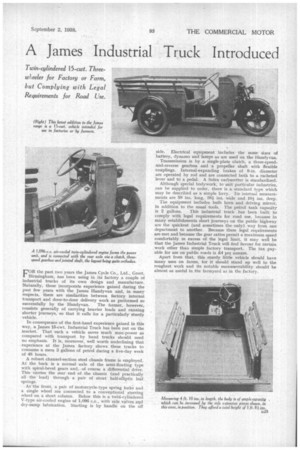A James Industrial Truck Introduced
Page 33

If you've noticed an error in this article please click here to report it so we can fix it.
Twin-cylindered 15-cwt. ThreeztAeeler for Factory or Farm, but Complying with Legal Requirements for Road Use.
VOR the past two years the James Cycle Co., Ltd., Greet, I Birmingham, has been using in its factory a couple of industrial trucks of its nwn design and manufacture. Naturally, these incorporate experience gained during the past few years with the James Handyvan and, in many respects, there are similarities between factory internal transport and door-to-door delivery work as performed so successfully by the Handyvan. The • former, however, consists generally of carrying heavier loads and running shorter journeys, so that it calls for a particularly sturdy vehicle.
In consequence of the first-hand experience gained in this way, a James 15-cwt, Industrial Truck has been put on the market. That such a vehicle saves much man-power as compared with transport by hand trucks should need no emphasis. It is, moreover, well worth underlining that . experience at the James factory shows these trucks to consume a mere 3 gallons of petrol during a five-day week of 48 hours.
A robust channel-section steel chassis frame is employed. At the back is a normal axle of the semi-floating type with spiral-bevel gears and, of course a differential drive. This carries the rear end of the chassis (and practically all the load) through a pair of stout half-elliptic leaf springs.
At the front, a pair of motorcycle-type spring forks and a single wheel are connected to a conventional steering wheel on a short column. Below this is a twiti-cylindered V-type air-cooled engine of 1,096 c.c., with side valves awl dry-sump lubrication. Starting is by handle on the off
side. Electrical equipment includes the same sizes of battery, dynamo and lamps as are used on the Handyvan.
Transmission is by a single-plate clutch, a three-speedand-reverse gearbox and a propeller shaft with flexible couplings. Internal-expanding brakes of 9-in, diameter are operated by rod and are connected both to a racheted lever and to a pedal. A Soles carburetter is standardized.
Although special bodywork, to suit particular industries, can be supplied to order, there is a• standard type which may be described as a simple lorry. Its internal measurements are 58 ins. long, 381 ins, wide and 101 ins. deep.
The equipment includes bulb horn and driving mirror, in addition to the usual tools. The petrol tank capacity is 2 gallons. This industrial truck has been built to comply with legal requirements for road use, because in many establishments short journeys on the public highway are the quickest (and sometimes the •only) way from one department to another. Because these legal requirements are met and because the gear ratios permit a maximum speed comfortably in excess of the legal limit, it may well be that the James Industrial Truck will find favour for certain work other than simple factory transport. The tax payable for use on public roads is £4 per annum.
Apart from that, this sturdy little vehicle should have many uses on farms, for it should stand up well to the roughest work and its notable manoeuvrability should be almost as useful in the farmyard as in the factory.




















































































